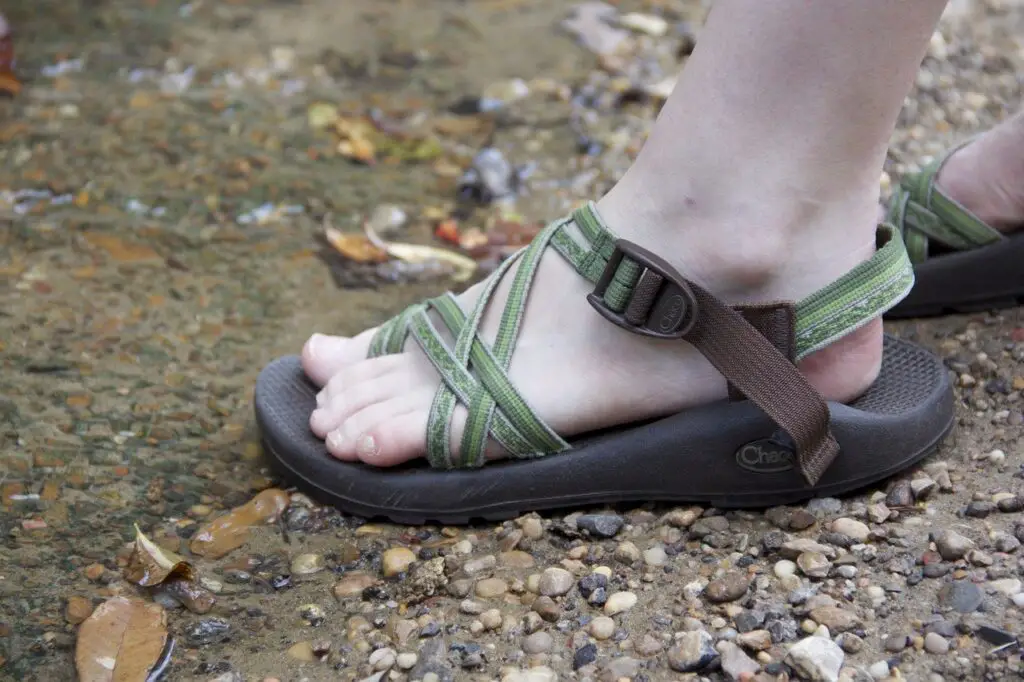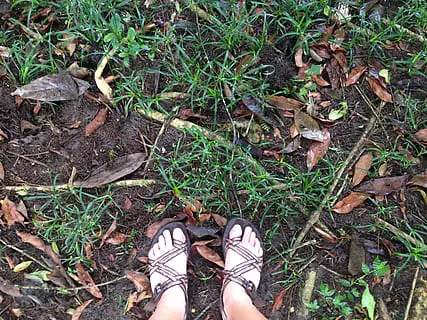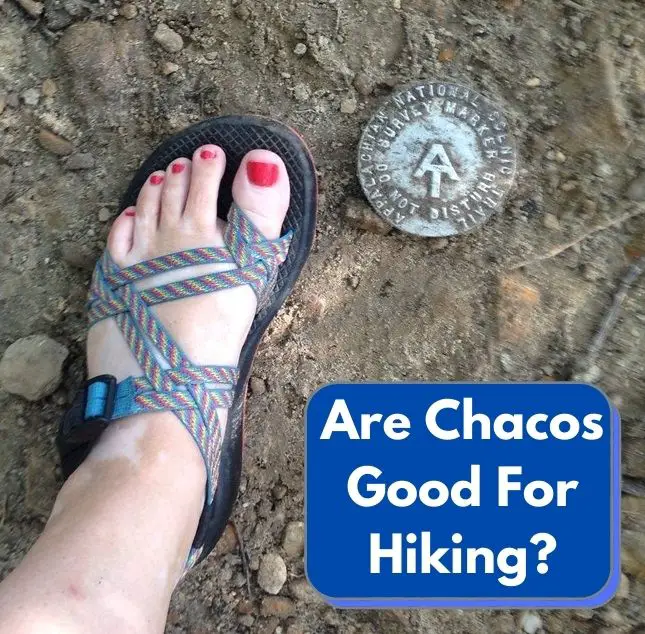Chacos are extremely popular sandals that have a reputation for being very comfortable and durable, making them a staple for many outdoor enthusiasts. But are Chacos good for hiking?
Chacos are a great choice for hiking sandals as they offer traction, underfoot support, and adjustability. However, Chacos do not offer as much foot protection or support as traditional hiking boots.
So while you can absolutely hike in Chacos, it doesn’t necessarily mean you should.
Let’s explore hiking in Chacos further in-depth below.

Hiking In Chacos
There are many strong opinions within the hiking community on what is the best type of footwear to use for hiking.
Ask ten different hikers and you’ll likely get ten different responses: some will say traditional hiking boots, others will insist that trail running shoes are superior, while a few will say that minimalist hiking shoes are the only way to go.
As with most things in life, whether or not chacos are good for hiking really is up to you and what conditions you’ll be using them in.
Pros Of Wearing Chacos For Hiking
Chacos Are Lightweight
Chacos are significantly lighter than old-school hiking boots, saving you energy on long hikes by not lugging the extra weight around.
No Blisters When You Hike In Chacos
Chacos let your feet breathe, cutting down on sweat, moisture, and friction, which are the big three main causes of hiking blisters.
The open design of Chacos and other sandals allows more air to get to your feet, reducing the moisture and friction.
Chacos Dry Quickly And Are Great For Crossing Water
No more worrying about how to dry out hiking boots if you’re sporting Chacos, as their simple materials and design allow them to dry quickly.
Your Chacos Can Come Off And On Easily
If you get a small stone or other debris in your Chacos, they’re very easy to take on and off to remove whatever’s in there.
Chaco Sandals Are Versatile
Chacos have tons of uses besides hiking, as their design and styling makes them good for everyday use around the house, running errands, or even at a lake or the beach.
Those are places where your hiking boots simply wouldn’t work, but Chacos are ready to roll!
Cons Of Wearing Chacos While Hiking
Chacos Leave Your Toes Exposed
While the breathability and freedom of hiking in sandals is nice, your toes and skin on your feet are exposed to heat, cold, sun, insects, snakes, roots, and rocks.
Nothing will make your hiking trip worse than a broken or stubbed toe or cuts on your feet, and that’s probably the biggest drawback of hiking in Chacos.
Chacos Don’t Protect Your Feet From The Elements
Your toes and feet don’t get as much sun as the rest of your skin, and wearing Chacos for hiking can leave you at risk for sunburns.
You Won’t Have As Much Traction In Chacos
Although Chacos are much better than regular sandals for providing grip, they don’t offer the lug patterns or outsoles that hiking boots do.
This doesn’t have to be a deal breaker as long as you are extra vigilant on the trail or if you are hiking a simpler trail.
The Sandal Straps On Your Chacos Can Chafe Your Skin
Your Chaco straps can develop into hotspots on your feet, especially in wet or sandy conditions.
If A Strap Fails On Your Chacos, You’re Up The Creek
Hiking in boots with a hole or broken lace isn’t much fun, but you can power through and get your hike finished up.
Alternatively, if your Chacos bust a strap, those sandals will no longer function!

Tips For Hiking In Chacos
Prep Your Feet For Hiking In Chaco Sandals
Building up calluses is going to help with any discomfort from getting stuff in between your sandals and your feet on the trail and also cut down on blisters.
Check out our guide on how to prepare your feet for hiking for some great tips here.
Additionally, you can pre-tape the hot spots on your feet using Moleskin, Leukotape, or Rock Tape to prevent blisters from forming while hiking.
Break Your Chacos In
Just like breaking hiking boots in, you also need to break in Chacos before your hikes.
Wear them around the house and while running errands to get them broken in, paying attention to any hot spots during the process.
Start Out Small With Chaco Hiking Sandals
After breaking in your hiking sandals, don’t go for a 10-hour hike! Start small, taking shorter hiking trips and building up the length gradually so you don’t accidentally overdo it.
Pay Attention To Your Chaco Straps And Adjust Them Properly
Chaco offers two variations of straps on their sandals: the Z1 and Z2.
The difference here is that the Z1 has no toe loop, while the Z2 does (making the Z1 better suited for hikers who wear hiking socks with their Chacos).
Chaco’s website has visuals on how to adjust the straps properly on their different models, which you should read through before hiking to ensure a great fit.
Think About The Trail Conditions
If you’ll be hiking a trail that has lots of brush, gravel, or thorny plants, you may want to think twice about wearing those Chacos!
Avoid Leather Chacos
Although the majority of Chacos sandals use synthetic materials, some models offer leather straps.
Leather causes more friction than synthetics and can also change in shape quite a bit when wet versus dry, so we don’t recommend hiking in leather Chacos.
Apply Sunscreen
Always apply sunscreen to your feet and toes when hiking in Chaco sandals (cover the rest of your skin, too).
Your toes and feet generally get less sun exposure than the rest of your skin, leaving them more prone to sunburn.
Wear Socks With Your Hiking Sandals
While we could debate the whole socks and sandals thing all day, you’ll need to put your fashion sense aside if you want to wear your Chacos on the trail.
By pairing some lightweight hiking socks with your Chacos, you’re giving your feet sun protection, some small extra layer of protection against insects and (maybe) snakes, and most importantly a barrier between the sandal strapsand your bare skin, reducing your chances for hot spots and blisters.
Which Chacos Are Best For Hiking?
If you’ve made it this far, you’ve probably made your mind up that you’ll be trying out some Chacos on your next hike.
Here are the best Chacos for hiking that we’ve reviewed:
Chacos Z/2

Chacos Z/2 sandals feature the toe strap for keeping your feet in place, making them a great choice for rugged terrain.
Chacos Z/Cloud2

The Z/Cloud2 line by Chacos places an emphasis on comfort, making them great for desert, scrambling over rocks, and mountain hiking.
Chacos Odyssey

Chacos’ Odyssey sandals are an outstanding choice for rugged terrain thanks to their toe protection and traction-positive luggy outsoles.
Chacos Z/1

Simple and no toe loop, the Chacos Z/1 men’s and Chacos Z/1 women’s classic sandals have good arch support and polyester webbing straps that adjust for a great fit, making them good all-around hiking sandals.
FAQs About Wearing Chacos For Hiking
Chacos are a good choice for hiking in sandals as they offer traction, underfoot support, and adjustability.
Chacos offer good arch support and can help improve body alignment.
They can also help to prevent heel pain, ankle pain, and discomfort from plantar fasciitis, making them great for your feet.
Chacos are great for water thanks to their waterproof foot bed and quick-drying polyester straps.
We think the best Chacos for hiking are the Chaco Odyssey sandals thanks to their toe protection and luggy outsole, making them more versatile than other Chaco models for more types of hikes.
Yes, Chacos are good for long hikes. In fact, many people have completed 14ers and even thru-hiked the Appalachian Trail in them!
The main way you can make your Chacos more comfortable is by wearing them more often to break them in.
Some users swear by putting them in the oven on a low temp for a few minutes, which softens the foot bed to help it mold to the shape of your feet more easily.
Yes. Wearing hiking socks with Chacos will prevent the straps from chafing your skin and will provide your toes and feet with a little extra protection from insects, weather, and possible abrasions from underbrush.
Chacos and other hiking sandals are great for sweaty feet as their open design promotes tons of air flow, keeping your feet dry as you hike.
No, as long as you take the time to break your Chacos in, they should not give you blisters.
Pay attention to hot spots during the break-in process and use tape on any hot spots if you’re on the trail.
This is really up to personal preference, but Chacos are known for having better soles and more supportive and comfortable foot beds, while Tevas are recognized as having more comfortable straps that are easier to adjust.
Most Chacos should only take a month or two to break in as long as you’re wearing them with some regularity.
Is Hiking In Chacos Sandals A Good Idea?
As we have covered here, while Chaco sandals do have their benefits, we think it’s better to stick with hiking boots or hiking shoes on the trail due to the overall safety and support benefits they offer.
If you’re planning on hiking paved or simple, short hikes on well-established trails, hiking sandals will do fine, but you’ll want to opt for hiking boots for anything more intense.
If you’re still exploring what kind of footwear to go with, check out our guides to the best men’s hiking boots under $100, the best women’s hiking boots under $100, the best hiking boots for flat feet, the best minimalist hiking shoes, and the best toe shoes for hiking while you’re here.

